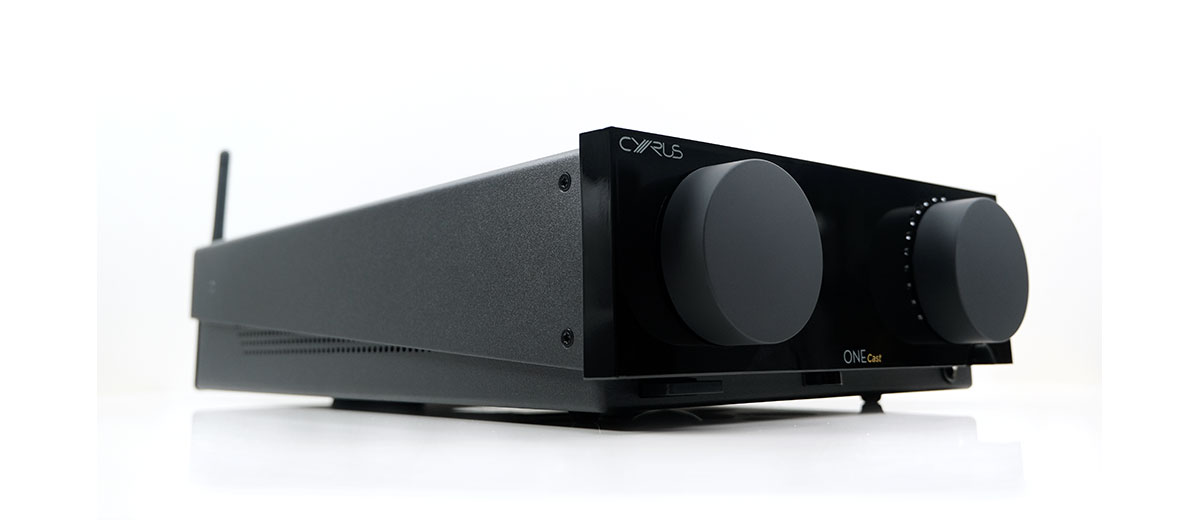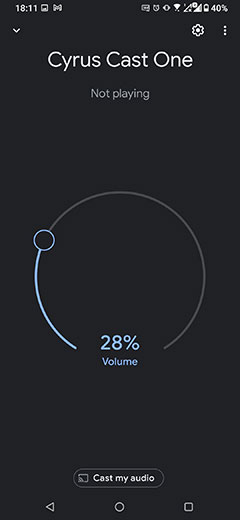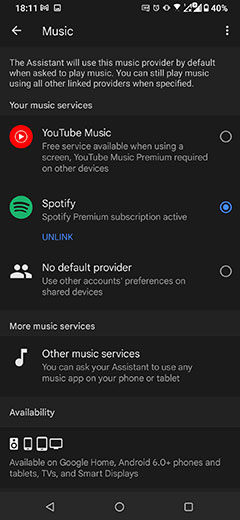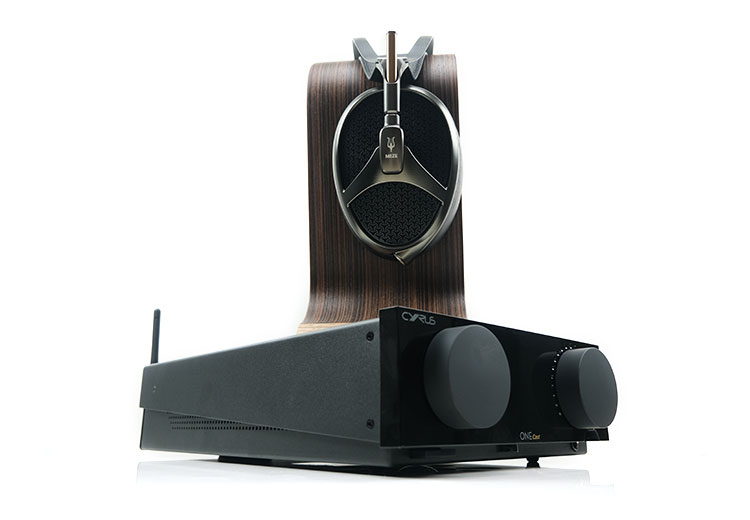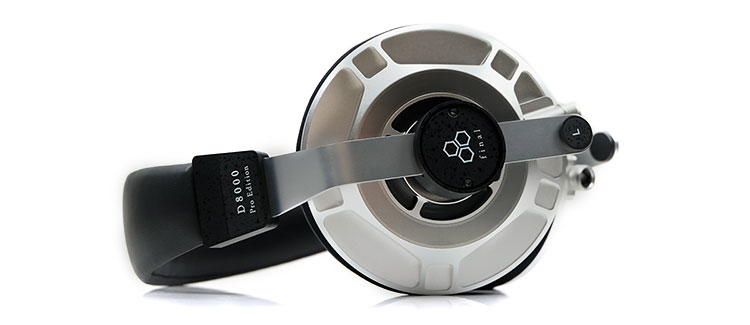Streaming Performance
WiFi
The primary method for streaming on the One Cast is via Chromecast using a 2.4GhZ bandwidth-capable WiFi receiver. That opens the system to a very wide range of cast-capable 3rd Party audio and video apps as well as simplifies the setup and control procedures via Google Home.
Via the Google Home main screen, you can see your One Cast as part of your room or group on the Google Home ‘home screen’. You can start then pulling in a whole host of services such as Netflix (audio only), YouTube Music, Spotify, Google Podcasts as well as add numerous compatible sources to transmit to the One Cast device.
For apps such as Spotify, TIDAL, Qobuz, and Roon, you will not really need Google Home as they all now have built-in casting capability. In all our tests, once the One Cast was WiFi ready, the aforementioned apps saw the device and streamed to it once the Chromecast handshake was completed which takes about 1-2 seconds max.
The one drawback, however, with Chromecast is its 24BIT/92kHz limit which does mean some tracks from Qobuz with their sampling rates will be downsampled. Switching to Airplay is lower at 16BIT/44.1 kHz which, although very easy to set up, is a bit too low for me.
Bluetooth
Bluetooth operability can be divided into two areas: initial setup and streaming. You do need a BT-capable smartphone out of the box to link with the One Cast via Google Home. This in turn allows Google Home to set up your WiFi pairing via your Phone.
This process is incredibly simple and can be completed in a matter of seconds or minutes. Once connected you will not require BT again for connections unless you wish to stream via Bluetooth.
I was half expecting the BT SBC connection to be full of horrible bloom and sounding quite wooly but I have to say the performance was much better than I expected compared to the full USB WASAPI experience using some 16BIT/44.1kHz files.
The overall timbral coloration remains largely unaffected and whilst there is a noticeable reduction in dynamic range with less staging width and a slight softness in the attack of the notes the BT performance never sounded horribly tinny or bloated.
Would I use the One Cast Bluetooth option? To be honest, only if I had to. If you want a proper wireless performance then casting via WiFi or USB audio are the more resolving choices with the One Cast.

Sound Impressions
Sound Impressions are based on the PO performance of the headphone amp using both Chromecast via WiFi and wired audio including USB (WASAPI). Source applications include Roon, TIDAL, and Qobuz via Android and a Windows-based laptop.
Summary
The One Cast AB amplifier has a very likable and somewhat beefy sound signature. That surprised me because the ES9018Q2M historically has always been engineered to deliver a neutral to clean sound with that classic Sabre treble shimmer in earlier models.
Granted, that was a few years ago but I never heard an amp with that DAC chipset behind it as inviting and beefy as the one used inside the One Cast. The closest might be the Cayin N5ii DAP from 2018 which also used an ES9018Q2M and tuned with neutral to natural tonal bias.
Here, the One Cast is less neutral with a weightier bass response and only starts to sound more neutral in terms of placement through the mids and vocal imaging. However, the neutral imaging does not really come with a thin brittle sound so vocals still have some pleasing texture to them.
Upper mids and high-frequency notes do thin out a bit more and become a bit more digital sounding but the Sabre glare as it was popularly known back in the day is still pleasingly nuanced rather than overt.
You can tease some shimmer out with a set of headphones that are brasher around 6-7k. Headphones such as the Audeze LCD-XC will accentuate a harder treble tone in percussion and falsetto vocal mixes that are handled better by high-end dedicated amp/DACs such as the Hugo 2 and Cayin iHA-6/iDAC-6.
However, with smoother-sounding headphones such as the Meze Empyrean and the Final D8000 Pro, the One Cast treble overtones vary from smooth to clear but never harsh.
Timbre
In short, this is dense and slightly warm to the low-end, cleaner in the highs, with a mix of warmth and neutral through the mids. A modern forgiving sound with a slightly smooth timbral coloration highly suited to streaming.
The kingpin of the One Cast headphone amplifier is that sub-bass response which is heavier in terms of quantity and girth than our compared amplifiers, the Hugo 2 and the Cayin iHA-6. It gives a certain sense of drive and above-average PRaT and pairs very nicely with modern pop, R’N’B standards. An almost perfect mix with the majority of tracks found on TIDAL.
Lower-mids instruments have a little bit of bloom which is more evident in the Chromecast performance becoming tighter and snappier when switching to the USB wired input. That does help to create a bit more space on the USB performance which I will get into in more detail in our staging description.
Vocal timbre is broad and erring to the slightly sweet and euphonic side benefitting from that planted low-end and a non-too pushy treble tuning. Attacks have just enough softness to prevent harsh sibilance creeping in with clean-sounding headphones though it won’t disguise percussion shimmer completely if the headphones are naturally peaky in the lower treble.
Staging
The One Cast does very well in terms of depth, and instruments at the very low-end do deliver some convincing solidity. However, width and height are more to the moderate side creating a slightly narrower stereo image compared to the likes of the Hugo 2 and the Cayin iHA-6, our two headphone amps we compared the One Cast to.
However, if there is a weak point it’s the dynamic range of the One Cast headphone amplifier. It lacks a little explosiveness, nuanced layering, and headroom compared to what some dedicated headphone amplifiers can deliver.
Yes, it does make it more forgiving for streaming content and yes, the weight and PRaT are quite good, even with high-end headphones. However, the instrumental separation and imaging placement are quite centered and comparatively compressed creating a more intimate staging quality in some respects and not quite as holographic or as airy as I would like to hear.
Synergy
Efficiency
Although the headphone amplifier output is single-ended only the power rating is pretty decent for a device of this type at 1W into a 32Ω load. That is usually enough power for most modern planars outside of the most demanding variants such as the Abyss Diana Phi, HIFIMAN Susvara, and the HE6SE.
Headphones such as the Final D8000 Pro, Meze’s Empyrean, and the Audeze LCD-XC 2021 will have no issues in terms of adequate power under load or current with the Class AB PO of the One Cast. I was barely hitting 10pm on the dial combined with Roon’s digital amp set at 41 and the D8000 Pro with very little additional current added for the Empyrean.
IEMs were initially a big surprise for me with the One Cast with a very black background with excellent volume control for both demanding and sensitive alike. Monitors such as the VE Elysium and the more sensitive Campfire Audio Andromeda has no issue or channel imbalance issues or any noticeable hiss.
However, this performance is more to do with the PO output impedance of the One Cast headphone amplifier which I believe is much higher than 1Ω creating a bit of skew with sensitive IEMs such as the Andromeda to get that quiet background.
I did notice that there was significantly less bass warmth in the performance of the Andromeda that was only corrected and sounding more natural when using the iFi Audio IEMatch impedance dongle. Still, for the additional $50 or so extra for the IEMatch you will get a lot of flexibility from the One Cast PO if you want to use IEMs.
Pairings
Generally speaking, the One Cast has a pleasing sound signature that makes it fairly amenable to most headphone pairings. However, my personal preference was with a relatively neutral to naturally tuned headphone such as the Final D8000 Pro or a smoother sound such as the Meze Empyrean.
I found headphones such as the Audeze LCD-XC 2021 to just be a bit too unforgiving of that slightly thinner treble shimmer from the One Cast headphone output. That’s a daily typical ES9018 sound for me but in this implementation, it is quite subtle.
It only comes out to play if the headphone in question has a fairly clean upper mids and lively lower-treble on the One Cast and the LCD-XC 2021’s 6-7k peak will emphasize that without EQ. You still get some solid bass but that is mixed with a bit of gloss on soprano or falsetto vocals that is toned down a bit more on the other two headphones.
The Meze Empyrean does best for smoothness and I like my vocals strong on this headphone. The One Cast’s neutral vocal imaging sometimes can take a backseat to the stronger sub-bass via Chromecast, however, the performance is a lot tighter and a little cleaner also with the USB WASAPI driver and higher resolution audio.
My favored pairing was the Final D8000 Pro. The overall sound signature is more neutral than the Empyrean but it has a better handle on the treble than the LCD-XC 2021. The sound is clean, expensive, and tight with great bass definition.
This might be a less forgiving combo than the Empyrean but the superior staging width and headroom creates a more impressive and articulate soundscape with the One Cast Headphone amplifier.
Phono Stage
My turntable setup is Rega Planar P1 Plus – ALO Audio Phono Stage – amplifier of choice with a budget solid-state Project Audio Phono S stage as a backup.
The MM stage using the One Cast only does very well with the P1 which is notoriously finicky for grounding through the tonearm and the dual RCA left channel cables.
There was a very low noise floor and only a small amount of hum once you got to a very high-volume level which is as good as you can get sometimes with the P1. This was via the PO of the headphone amplifier using a medium-efficiency Final D8000 Pro planar headphone pairing.
The MM stage/headphone output of the One Cast is superior to the Project Audio Phono S box though the tonal quality from the One Cast PO output, (Phono S via AV) is similar. Both had a degree of warmth and solidity on the low-end with a neutral vocal placement.
The key difference was the better bass response of the One Cast MM stage with a superior dynamic range performance. The Phono S is a little flatter for bass and more open sounding in the mids but it did not sound quite as vivid as I had hoped it would. It also runs a bit quieter for volume than I was expecting compared to the direct MM input of the One Cast.
The ALO Audio Phone Stage dramatically upgrades the resolution and dynamic range of the Rega P1 Plus via the One Cast headphone output requiring far less volume to match.
Vocal are much clearer, the treble is cleaner and the bass is more precise. That should not be surprising given its price but the One Cast headphone amp does reflect the improvements over the internal MM quite well.
Click on page 3 below for select comparisons

